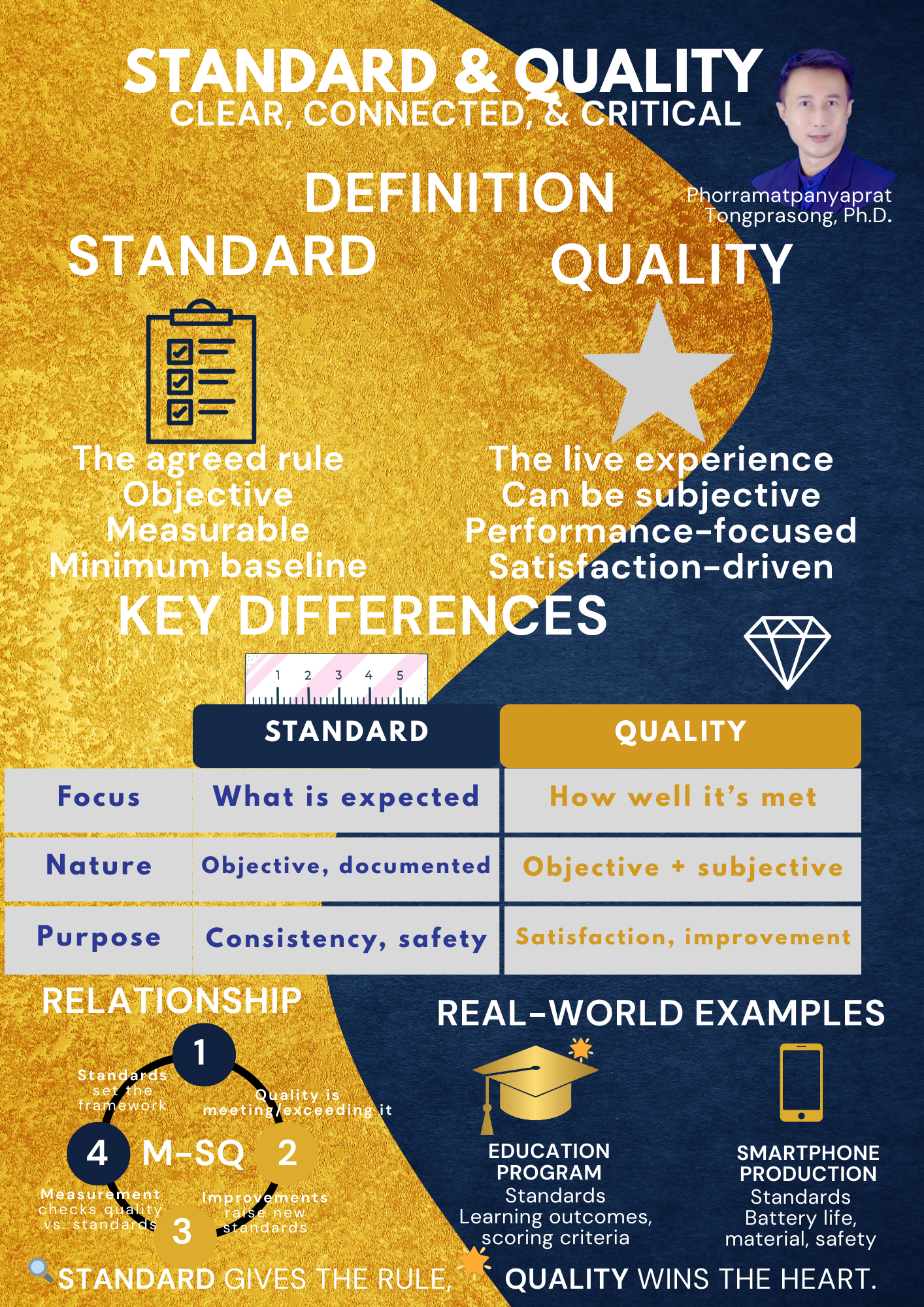MUST-WISDOM:
The “Standard” and “Quality”
The “Standard” and “Quality”

ASST. PROF. PHORRAMATPANYAPRAT TONGPRASONG, Ph.D., FHEA UKPSF
》》》》》》》》》》
June, 2025
>>>>>>>>>>

[PDF]
The terms “standard” and “quality” are fundamental concepts in various fields, from manufacturing to education, and while closely intertwined, they represent distinct ideas. The program’s understanding of “competency,” as derived from Dr. Phorramatpanyaprat Tongprasong thesis, inherently acknowledges the role of defined expectations (standards) in achieving desired outcomes (quality), particularly in generic skills like “Thinking” and “Acting,” and implicitly through “digital technology” and “application development” (Tongprasong, 2025). As shown in Figure.
Differentiation
Standard
A standard is a defined, measurable benchmark, a set of established requirements, specifications, guidelines, or characteristics that a product, service, or process should meet (ISO, n.d.). It represents a formal agreement or a documented set of criteria used as a rule, basis, or example.1Standards are often developed by authoritative bodies, industry organizations, or regulatory agencies to ensure consistency, compatibility, and a minimum acceptable level of performance. They are prescriptive, indicating what needs to be achieved.
· Focus: Prescription; what is expected or required.
· Nature: Objective, often quantitative, documented, and formal.
· Purpose: To provide uniformity, consistency, safety, and a baseline for performance; to facilitate interoperability and ensure minimum compliance.
Quality
Quality refers to the degree to which a set of inherent characteristics fulfills requirements (ISO, n.d.). More broadly, it’s about how well a product, service, or process actually meets or exceeds the defined standards, and, crucially, how well it satisfies customer needs and expectations. Quality is often perceived subjectively by the end-user, encompassing attributes like reliability, durability, performance, and customer satisfaction (Deming, 2000). It is descriptive, indicating how well something performs.
· Focus: Performance; how well requirements are met and expectations are satisfied.
· Nature: Can be objective (meeting specifications) but also highly subjective (customer perception, value, delight).
· Purpose: To achieve customer satisfaction, build trust, enhance reputation, ensure effectiveness, and drive continuous improvement.
Relation
Standards and quality are fundamentally interdependent. Standards provide the framework against which quality is assessed and achieved.
1. Standards as the Foundation for Quality: Standards set the fundamental criteria and expectations. Without clear standards, “quality” becomes an ambiguous concept, lacking a measurable benchmark for evaluation. Adhering to standards is the first step towards achieving quality.
2. Quality as the Outcome of Meeting/Exceeding Standards:
A high-quality product or service is one that consistently meets, and often exceeds, the relevant standards. While meeting standards ensures a minimum level of quality, truly high quality often involves surpassing these benchmarks in ways that delight customers or offer superior performance (Crosby, 1979).
3. Continuous Improvement Loop: The pursuit of higher quality often leads to the development of new or updated standards. As organizations innovate and discover better practices to deliver superior products or services, these advancements can be formalized into industry-wide or organizational standards, thereby raising the overall baseline for quality.
4. Measurement and Evaluation: Standards provide the objective criteria for measuring and evaluating quality. Performance against established standards is a key indicator of quality levels, allowing for systematic assessment and improvement initiatives.
Examples
1. Education Program (Aligned with program context)
¬ Standard:
· Curriculum Standard: The program must include modules on “higher-order cognitive skills” (e.g., critical thinking, problem-solving) and practical “application development” with specific learning outcomes articulated for each. (This aligns with Tongprasong “Thinking” and “Acting” generic outcomes and the implicit “digital technology” focus.)
· Assessment Standard: All graduates must demonstrate proficiency in designing a functional digital application by achieving a minimum score of 70% on a capstone project assessed against a rubric covering design, functionality, and user experience.
· Instructor Competency Standard: All faculty teaching digital technology courses must hold industry certifications relevant to the application development tools used in the curriculum.
¬ Quality:
· High Quality: A program where graduates consistently not only meet but exceed the capstone project’s requirements, developing innovative and highly functional applications that solve real-world problems. Alumni are highly sought after by employers for their strong critical thinking, proactive problem-solving, and advanced digital application skills (reflecting the “Thinking” and “Acting” generic competencies). Student feedback consistently praises the relevance of the curriculum and the practical skills gained, leading to high satisfaction and strong employment rates. This demonstrates an effective realization of generic competencies within the digital domain (Sarwono & Arsianti, 2025).
· Low Quality: A program where graduates barely pass the capstone project, developing applications with significant bugs or limited functionality. Employers report that graduates lack strong problem-solving abilities and practical digital skills. While the curriculum might technically meet the standards, the delivery and outcome fail to produce graduates with the high level of generic and digital competencies expected, resulting in low student satisfaction and poor employment outcomes.
2. Manufacturing: Smartphone Production
¬ Standard:
· Battery Life Standard: The smartphone’s battery must sustain at least 10 hours of continuous video playback.
· Material Standard: The phone’s casing must be made from a specific grade of aluminum alloy, meeting predefined hardness and scratch resistance tests (e.g., Mohs hardness scale rating of 6).
· Safety Standard: The device must pass all regulatory certifications for electromagnetic radiation (SAR) and battery safety (e.g., UL 2054).
¬ Quality:
· High Quality: A smartphone that reliably offers 12+ hours of video playback, whose aluminum casing shows minimal scratching after months of use, and which has a consistently smooth user interface. Customers perceive it as durable, reliable, and user-friendly, leading to high satisfaction and positive brand reputation. The product not only meets standards but offers an exceptional user experience (Spante et al., 2025).
· Low Quality: A smartphone where the battery life frequently drops below 10 hours within a few months, the casing scratches easily, and the operating system often lags or crashes. While it might have technically passed initial safety certifications, its performance and durability fall short of user expectations, leading to frequent returns and negative reviews.
Deming, W. E. (2000). Out of the crisis. MIT Press.
ISO (International Organization for Standardization). (n.d.). ISO 9000: Quality management systems—Fundamentals and vocabulary. Retrieved July 24, 2025,
Sarwono, J., & Arsianti, L. P. (2025). Analysis of the influence of digital competency on the effectiveness of technology-based training. Growth Journal Management and Business, 2(2), 76–84. https://doi.org/10.59422/growth.v2i02.652
Spante, M., Hashemi, S. S., Lundin, M., & Al-Khalifa, H. (2025). Digital competence and digital literacy in higher education research: Systematic review of concept use. Education and Information Technologies. Advance online publication. https://doi.org/10.1080/2331186X.2018.1519143
Tongprasong, P. (2023). ADMISTRATIVE MODEL DEVELOPING ACHIEVEMENT ORIENTED AND CREATIVE WORK OF THE RATANAKOSIN RAJABHAT UNIVERSITY INSTRUCTORS [Doctoral dissertation, University of Phayao].
Contact:
5th Fl., 32 Bld.
Suan Dusit University,
295 Nakhonratchasima RD., Dusit,
Dusit, BKK, Thailand 10300.
TEL. +6622445748
Êӹѡ§Ò¹ËÅÑ¡ÊÙµÃ
ºÃÔËÒøØáԨºÑ³±Ôµ
ÊÒ¢ÒÇÔªÒ¸ØáԨÊÃéÒ§ÊÃäìáÅÐà·¤â¹âÅÂÕ´Ô¨Ô·ÑÅ
ÍÒ¤Òà 32 ªÑé¹ 5
ÁËÒÇÔ·ÂÒÅÑÂÊǹ´ØÊÔµ
àÅ¢·Õè 295 ¶¹¹¹¤ÃÃÒªÊÕÁÒ
á¢Ç§´ØÊÔµ ࢵ´ØÊÔµ
¡Ãا෾ÁËÒ¹¤Ã 10300
â·ÃÈѾ·ì 02 244 5748
ptongprasong@gmail.com
LINE OA @mustland
Since: June, 2025